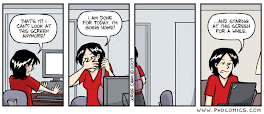
Causes
As I explain in a previous post, presbyopia is a visual disorder that is product of the time as it goes by.
When we look something at near something in order to focus and to see clear, a phenomenon is caused in our eyes called ACCOMMODATION, and the lens has to change its shape so that the image of what we see, is focused on the retina. But over the years, on one hand, the ciliary muscle, as the rest of body muscles, gets more rigid and shorter; and on the other hand, the lens increases the thickness of its faces, thus losing its elasticity (this therory is the most approved one). So, the muscle loses the ability to contract itself to allow that the lens to be more convex (at the same time, the crystalline lens does not do it because of its stiffness), and the accommodation does not happen.
This loss of accommodation process is gradual. It begins affecting the vision in the closest distance, and the changes of focus in different near distances are slower and with worse quality (those changes of focus are what we call “accommodative flexibility”). Little by little the ability to focus on near distances and increasingly farther from oneself its more difficult; this happens when our arms begin to stretch and in a certain moment they seem short. When it happens, this indicates that our focus is failing and we need a lens that compensates the accommodative effort that we can not perform anymore.
When a child is 10 years old, has an accommodation of around 14 diopters (that means, the closest distance where she can focus something very small is at around 7 cm); this quantity decreases linearly with the age, until that, at 50 years old, the accommodation is around 2.50 diopters (the closest distance where she can focus something very small is at around 40 cm, as you see the focusing ability has decreased almost 6 times the one of the child).
 This process begins between the 40’s and 50’s (depending on the refractive error that we already have at a young age; at the beginning the presbyopia starts adding a little positive lens for near distance -1.00 diopter approximately - over the graduation that we need to see far away); it usually stops around 58 years old (with a addition of around 2.25 or 2.50 diopters).
This process begins between the 40’s and 50’s (depending on the refractive error that we already have at a young age; at the beginning the presbyopia starts adding a little positive lens for near distance -1.00 diopter approximately - over the graduation that we need to see far away); it usually stops around 58 years old (with a addition of around 2.25 or 2.50 diopters).Presbyopia equally affects everyone, but hyperopic people start to suffer it at an earlier age than the emmetropic one; and these ones earlier than myopic people. Some of these myopic people (low and medium), when the presbyopia appears in their lifes, they are capable to read without using their eyeglasses, because of the compensation that is caused between both phenomenons.
From the moment presbyopia appears, this increases during a period of 10 or 12 years and then it is strabilized. Some of you, seeing how fast presbyopia increases when it begins, might think that it will never stop, but I assure you that it does.
In the case of some emmetropic or low hyperopic people, they suffer an increase of hyperopia after using reading eyeglasses of +1.00 dipoter during some time, when presbyopia is evident; so that after a couple of years, that graduation is not enough for the close up tasks, but they are only useful for distance vision. This is called HYPEROPIA OF PRESBYOPIA.
Risk Factors
According to American Optometric Association

RELATED POST
Physiological defect: Presbyopia.(1) Vision, Appearance and Symptoms
Refractive visual disorders. Some clarifications.
Some numbers...







